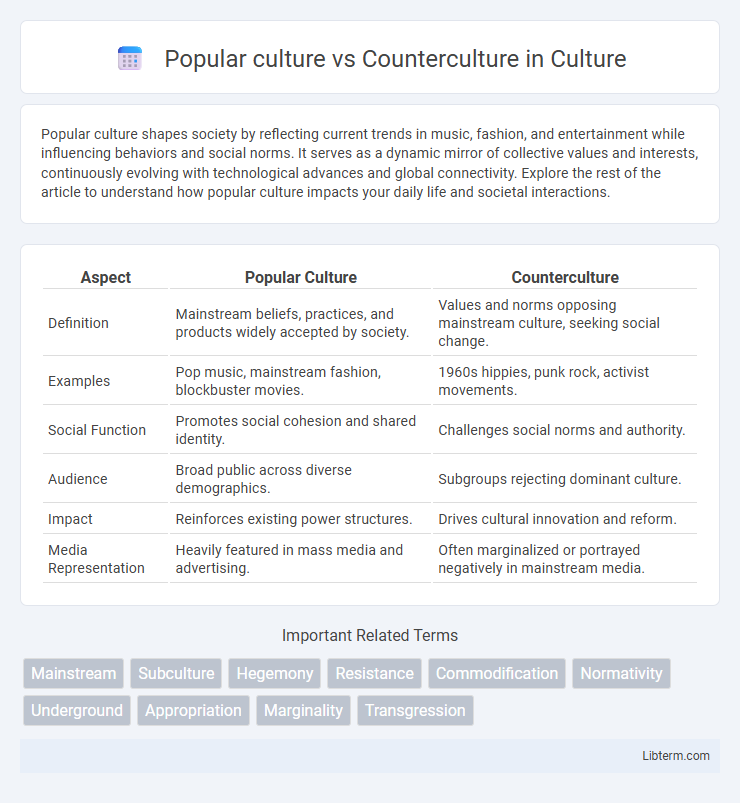Popular culture shapes society by reflecting current trends in music, fashion, and entertainment while influencing behaviors and social norms. It serves as a dynamic mirror of collective values and interests, continuously evolving with technological advances and global connectivity. Explore the rest of the article to understand how popular culture impacts your daily life and societal interactions.
Table of Comparison
| Aspect | Popular Culture | Counterculture |
|---|---|---|
| Definition | Mainstream beliefs, practices, and products widely accepted by society. | Values and norms opposing mainstream culture, seeking social change. |
| Examples | Pop music, mainstream fashion, blockbuster movies. | 1960s hippies, punk rock, activist movements. |
| Social Function | Promotes social cohesion and shared identity. | Challenges social norms and authority. |
| Audience | Broad public across diverse demographics. | Subgroups rejecting dominant culture. |
| Impact | Reinforces existing power structures. | Drives cultural innovation and reform. |
| Media Representation | Heavily featured in mass media and advertising. | Often marginalized or portrayed negatively in mainstream media. |
Defining Popular Culture and Counterculture
Popular culture encompasses mainstream ideas, practices, and products widely accepted and consumed by the general public, including music, fashion, and entertainment that reflect societal values. Counterculture represents distinct groups that actively reject and challenge dominant cultural norms through alternative lifestyles, ideologies, and artistic expressions. These opposing cultural dynamics shape social identity, influence political movements, and drive cultural evolution within society.
Historical Origins of Counterculture Movements
Counterculture movements historically emerged as reactions to mainstream cultural norms, with roots in the 1960s civil rights activism, anti-Vietnam War protests, and the rise of the hippie movement. These movements sought to challenge established social values, promote alternative lifestyles, and advocate for political change, often emphasizing peace, environmentalism, and personal freedom. Key events such as the Summer of Love (1967) and Woodstock (1969) symbolize the historical origins and cultural impact of counterculture movements in the United States and beyond.
Mainstream Trends vs. Alternative Lifestyles
Popular culture embodies mainstream trends that dominate media, entertainment, fashion, and social norms, reflecting widespread societal values and consumer behavior. Counterculture challenges these norms by promoting alternative lifestyles, often emphasizing social change, individualism, and resistance to conventional practices. The dynamic tension between popular culture and counterculture drives cultural evolution and shapes identity formation across generations.
Influential Figures in Popular and Counterculture
Pop icons like Elvis Presley and Michael Jackson shaped popular culture through music and mass media, influencing fashion, language, and societal norms worldwide. In contrast, counterculture figures such as Bob Dylan and Patti Smith challenged mainstream values by promoting political activism and alternative lifestyles during the 1960s and 1970s. These influential figures embodied the tension between conformity and rebellion, driving cultural evolution and social change.
Media Representation: Pop Culture vs. Counterculture
Popular culture dominates mainstream media through widespread representation in television, music, and advertising, reinforcing societal norms and consumer values. Counterculture receives limited media exposure, often portrayed through independent films, underground publications, and digital platforms that challenge mainstream ideologies. Media representation of counterculture emphasizes alternative lifestyles and resistance to dominant cultural narratives, highlighting social dissent and innovation.
Impact on Fashion, Music, and Art
Popular culture drives mainstream trends in fashion, music, and art by reflecting widespread consumer preferences and media influence, leading to mass adoption of styles like fast fashion, pop music, and commercial art. Counterculture challenges these norms by promoting alternative expressions through punk fashion, underground music scenes, and avant-garde art that reject commercialization and emphasize individuality. This dynamic tension fuels innovation, with countercultural movements often inspiring later mainstream acceptance and evolving cultural aesthetics.
Social Change Driven by Counterculture
Counterculture movements, such as the 1960s hippie and civil rights movements, challenge dominant social norms by promoting alternative values that drive significant social change. These movements influence legislation, cultural attitudes, and individual behaviors, fostering greater acceptance of diversity and equality. The dynamic tension between popular culture and counterculture propels societal evolution by questioning established power structures and encouraging progressive reform.
Commercialization of Counterculture
Counterculture movements, originally defined by their opposition to mainstream societal values, often become commercialized as brands co-opt their symbols and ideals for mass marketing. This commercialization dilutes the authentic messages of counterculture, transforming rebellious expressions into profitable trends within popular culture. As a result, counterculture icons and fashion aesthetics are repurposed to appeal to wider audiences, blurring the lines between genuine subversive movements and consumer-driven popularity.
Conflict and Fusion Between Pop and Counterculture
Popular culture and counterculture often conflict as mainstream values clash with alternative beliefs and lifestyles, creating societal tension that challenges dominant norms. Despite these conflicts, countercultural ideas frequently influence popular culture, leading to a fusion where rebellious styles, music, and ideologies are absorbed and commercialized. This dynamic interplay shapes evolving cultural landscapes, reflecting ongoing negotiations between conformity and resistance within society.
Lasting Legacy in Modern Society
Popular culture shapes mainstream values and trends through widespread media, entertainment, and consumer habits, embedding a collective identity that drives societal norms. Counterculture movements challenge these norms by promoting alternative lifestyles and resistance to dominant ideologies, leaving a lasting legacy of social reform and activism. Both influence modern society by continuously redefining cultural boundaries and fostering diversity in thought, art, and social practices.
Popular culture Infographic

 libterm.com
libterm.com